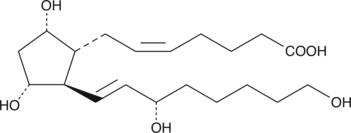Chemicals
Showing 4801–4950 of 41137 results
-
20-hydroxy LTB4 is a metabolite of LTB4 in human neutrophils. In human leukocytes, LTB4 is inactivated by the enzyme LTB4 20-hydroxylase. 20-hydroxy LTB4 is not only much less active (~5%) compared to LTB4 in causing degranulation of PMNL,{399} but actually inhibits LTB4-induced degranulation of human neutrophils (Ki = 13.3 nM).{1106} However, 20-hydroxy LTB4 is as active as LTB4 in contracting parenchymal strips from guinea pig lung.{377} 20-hydroxy LTB4 retains considerable ligand binding affinity at the BLT2 receptor,{8743,9270} but does not appear to function as an agonist.{8525}
Brand:CaymanSKU:20190 -Available on backorder
20-hydroxy Prostaglandin E2 (20-hydroxy PGE2) is a product of cytochrome P450 metabolism of PGE2 (Item No. 14010).{4309,726} ω-Oxidation at C-20 followed by β-oxidation and the loss of up to four carbons from the lower side chain is a prominent metabolic pathway for PGE2. 20-hydroxy PGE2 is the putative first intermediate in this chain of chemical transformations.
Brand:CaymanSKU:-20-hydroxy Prostaglandin E2 (20-hydroxy PGE2) is a product of cytochrome P450 metabolism of PGE2 (Item No. 14010).{4309,726} ω-Oxidation at C-20 followed by β-oxidation and the loss of up to four carbons from the lower side chain is a prominent metabolic pathway for PGE2. 20-hydroxy PGE2 is the putative first intermediate in this chain of chemical transformations.
Brand:CaymanSKU:-20-hydroxy Prostaglandin E2 (20-hydroxy PGE2) is a product of cytochrome P450 metabolism of PGE2 (Item No. 14010).{4309,726} ω-Oxidation at C-20 followed by β-oxidation and the loss of up to four carbons from the lower side chain is a prominent metabolic pathway for PGE2. 20-hydroxy PGE2 is the putative first intermediate in this chain of chemical transformations.
Brand:CaymanSKU:-20-hydroxy Prostaglandin E2 (20-hydroxy PGE2) is a product of cytochrome P450 metabolism of PGE2 (Item No. 14010).{4309,726} ω-Oxidation at C-20 followed by β-oxidation and the loss of up to four carbons from the lower side chain is a prominent metabolic pathway for PGE2. 20-hydroxy PGE2 is the putative first intermediate in this chain of chemical transformations.
Brand:CaymanSKU:-20-hydroxy Prostaglandin F2α (20-hydroxy PGF2α) is the ω-oxidation product of PGF2α. Cultured type II alveolar cells from pregnant rabbits metabolize exogenous PGF2α via microsomal cytochrome P450 ω-oxidation, producing 20-hydroxy PGF2α and its 15-hydroxy PGDH metabolites. Cells from male rabbits exhibit only the 15-hydroxy PGDH pathway.{4308}
Brand:CaymanSKU:-Out of stock
20-hydroxy Prostaglandin F2α (20-hydroxy PGF2α) is the ω-oxidation product of PGF2α. Cultured type II alveolar cells from pregnant rabbits metabolize exogenous PGF2α via microsomal cytochrome P450 ω-oxidation, producing 20-hydroxy PGF2α and its 15-hydroxy PGDH metabolites. Cells from male rabbits exhibit only the 15-hydroxy PGDH pathway.{4308}
Brand:CaymanSKU:-Out of stock
20-hydroxy Prostaglandin F2α (20-hydroxy PGF2α) is the ω-oxidation product of PGF2α. Cultured type II alveolar cells from pregnant rabbits metabolize exogenous PGF2α via microsomal cytochrome P450 ω-oxidation, producing 20-hydroxy PGF2α and its 15-hydroxy PGDH metabolites. Cells from male rabbits exhibit only the 15-hydroxy PGDH pathway.{4308}
Brand:CaymanSKU:-Out of stock
20(R)-Ginsenoside Rg3 is a saponin that has been found in P. ginseng and inhibits angiogenesis.{39807} 20(R)-Ginsenoside Rg3 (0.001-1 μM) dose-dependently reduces proliferation, capillary tube branching, and the expression of matrix metalloproteinase-9 (MMP-9) and MMP-2 in human umbilical vein endothelial cells (HUVECs). It reduces tumor cell invasion of MM1 rat hepatoma, B16FE7 mouse melanoma, OC-10 human lung carcinoma, and PSN-1 human pancreatic adenocarcinoma cells in vitro by 89, 73.7, 84.2, and 59.1%, respectively, when used at a concentration of 25 µM.{39808} However, it does not inhibit the proliferation of MM1 cells when used at concentrations ranging from 1.6 to 64 µM. 20(R)-Ginsenoside Rg3 (20 mg/kg) reduces tumor volume, increases the tumor necrosis rate by approximately 16%, and increases survival in a human Lewis lung carcinoma mouse xenograft model.{24955} It also reduces the total number of B16-BL6 melanoma cell and 26-M3.1 colon carcinoma cell lung colonies in mice by 27 and 51%, respectively, when administered at a dose of 100 µg.{39809} Topical administration of 20(R)-ginsenoside Rg3 (0.05% w/v) reduces ear thickness by 47.5% compared with control animals in a mouse model of oxazolone-induced contact dermatitis and reduces expression of COX-2, IL-4, IL-1, IFN, and TNF mRNA by greater than 25%.{36226}
Brand:CaymanSKU:24978 - 100 mgAvailable on backorder
20(R)-Ginsenoside Rg3 is a saponin that has been found in P. ginseng and inhibits angiogenesis.{39807} 20(R)-Ginsenoside Rg3 (0.001-1 μM) dose-dependently reduces proliferation, capillary tube branching, and the expression of matrix metalloproteinase-9 (MMP-9) and MMP-2 in human umbilical vein endothelial cells (HUVECs). It reduces tumor cell invasion of MM1 rat hepatoma, B16FE7 mouse melanoma, OC-10 human lung carcinoma, and PSN-1 human pancreatic adenocarcinoma cells in vitro by 89, 73.7, 84.2, and 59.1%, respectively, when used at a concentration of 25 µM.{39808} However, it does not inhibit the proliferation of MM1 cells when used at concentrations ranging from 1.6 to 64 µM. 20(R)-Ginsenoside Rg3 (20 mg/kg) reduces tumor volume, increases the tumor necrosis rate by approximately 16%, and increases survival in a human Lewis lung carcinoma mouse xenograft model.{24955} It also reduces the total number of B16-BL6 melanoma cell and 26-M3.1 colon carcinoma cell lung colonies in mice by 27 and 51%, respectively, when administered at a dose of 100 µg.{39809} Topical administration of 20(R)-ginsenoside Rg3 (0.05% w/v) reduces ear thickness by 47.5% compared with control animals in a mouse model of oxazolone-induced contact dermatitis and reduces expression of COX-2, IL-4, IL-1, IFN, and TNF mRNA by greater than 25%.{36226}
Brand:CaymanSKU:24978 - 250 mgAvailable on backorder
20(R)-Ginsenoside Rg3 is a saponin that has been found in P. ginseng and inhibits angiogenesis.{39807} 20(R)-Ginsenoside Rg3 (0.001-1 μM) dose-dependently reduces proliferation, capillary tube branching, and the expression of matrix metalloproteinase-9 (MMP-9) and MMP-2 in human umbilical vein endothelial cells (HUVECs). It reduces tumor cell invasion of MM1 rat hepatoma, B16FE7 mouse melanoma, OC-10 human lung carcinoma, and PSN-1 human pancreatic adenocarcinoma cells in vitro by 89, 73.7, 84.2, and 59.1%, respectively, when used at a concentration of 25 µM.{39808} However, it does not inhibit the proliferation of MM1 cells when used at concentrations ranging from 1.6 to 64 µM. 20(R)-Ginsenoside Rg3 (20 mg/kg) reduces tumor volume, increases the tumor necrosis rate by approximately 16%, and increases survival in a human Lewis lung carcinoma mouse xenograft model.{24955} It also reduces the total number of B16-BL6 melanoma cell and 26-M3.1 colon carcinoma cell lung colonies in mice by 27 and 51%, respectively, when administered at a dose of 100 µg.{39809} Topical administration of 20(R)-ginsenoside Rg3 (0.05% w/v) reduces ear thickness by 47.5% compared with control animals in a mouse model of oxazolone-induced contact dermatitis and reduces expression of COX-2, IL-4, IL-1, IFN, and TNF mRNA by greater than 25%.{36226}
Brand:CaymanSKU:24978 - 50 mgAvailable on backorder
20(R)-Ginsenoside Rh2 is a steroid glycoside originally isolated from P. ginseng and an isomer of 20(S)-ginsenoside Rh2 (Item No. 23390) that has diverse biological activities.{40332,42828,42829} It inhibits the replication of murine gammaherpes virus 68 (MHV-68; IC50 = 2.77 μM) and the lytic replication of human gammaherpes virus in BC3 cells.{40332} 20(R)-Ginsenoside Rh2 reduces levels of nitric oxide (NO), prostaglandin E2 (PGE2; Item No. 14010), reactive oxygen species (ROS), and pro-matrix metalloproteinase-9 (pro-MMP-9) in LPS-stimulated RAW 264.7 cells.{42828} It also reduces ROS production and MMP-9 and MMP-2 activity in HaCat human keratinocytes. 20(R)-Ginsenoside Rh2 (4 mg/kg) induces tumor cell apoptosis and reduces tumor growth in an H22 hepatocellular carcinoma mouse xenograft model.{42829}
Brand:CaymanSKU:27300 - 1 mgAvailable on backorder
20(R)-Ginsenoside Rh2 is a steroid glycoside originally isolated from P. ginseng and an isomer of 20(S)-ginsenoside Rh2 (Item No. 23390) that has diverse biological activities.{40332,42828,42829} It inhibits the replication of murine gammaherpes virus 68 (MHV-68; IC50 = 2.77 μM) and the lytic replication of human gammaherpes virus in BC3 cells.{40332} 20(R)-Ginsenoside Rh2 reduces levels of nitric oxide (NO), prostaglandin E2 (PGE2; Item No. 14010), reactive oxygen species (ROS), and pro-matrix metalloproteinase-9 (pro-MMP-9) in LPS-stimulated RAW 264.7 cells.{42828} It also reduces ROS production and MMP-9 and MMP-2 activity in HaCat human keratinocytes. 20(R)-Ginsenoside Rh2 (4 mg/kg) induces tumor cell apoptosis and reduces tumor growth in an H22 hepatocellular carcinoma mouse xenograft model.{42829}
Brand:CaymanSKU:27300 - 10 mgAvailable on backorder
20(R)-Ginsenoside Rh2 is a steroid glycoside originally isolated from P. ginseng and an isomer of 20(S)-ginsenoside Rh2 (Item No. 23390) that has diverse biological activities.{40332,42828,42829} It inhibits the replication of murine gammaherpes virus 68 (MHV-68; IC50 = 2.77 μM) and the lytic replication of human gammaherpes virus in BC3 cells.{40332} 20(R)-Ginsenoside Rh2 reduces levels of nitric oxide (NO), prostaglandin E2 (PGE2; Item No. 14010), reactive oxygen species (ROS), and pro-matrix metalloproteinase-9 (pro-MMP-9) in LPS-stimulated RAW 264.7 cells.{42828} It also reduces ROS production and MMP-9 and MMP-2 activity in HaCat human keratinocytes. 20(R)-Ginsenoside Rh2 (4 mg/kg) induces tumor cell apoptosis and reduces tumor growth in an H22 hepatocellular carcinoma mouse xenograft model.{42829}
Brand:CaymanSKU:27300 - 25 mgAvailable on backorder
20(R)-Ginsenoside Rh2 is a steroid glycoside originally isolated from P. ginseng and an isomer of 20(S)-ginsenoside Rh2 (Item No. 23390) that has diverse biological activities.{40332,42828,42829} It inhibits the replication of murine gammaherpes virus 68 (MHV-68; IC50 = 2.77 μM) and the lytic replication of human gammaherpes virus in BC3 cells.{40332} 20(R)-Ginsenoside Rh2 reduces levels of nitric oxide (NO), prostaglandin E2 (PGE2; Item No. 14010), reactive oxygen species (ROS), and pro-matrix metalloproteinase-9 (pro-MMP-9) in LPS-stimulated RAW 264.7 cells.{42828} It also reduces ROS production and MMP-9 and MMP-2 activity in HaCat human keratinocytes. 20(R)-Ginsenoside Rh2 (4 mg/kg) induces tumor cell apoptosis and reduces tumor growth in an H22 hepatocellular carcinoma mouse xenograft model.{42829}
Brand:CaymanSKU:27300 - 5 mgAvailable on backorder
Ginsenoside Rh2 is a steroid glycoside found in plants of the genus Panax that has diverse biological activities.{40327,40328,40329,40330,40331} It inhibits release of β-hexosaminidase from RBL-2H3 cells (IC50 = 100 μM) and inhibits the IgE-dependent passive cutaneous anaphylaxis reaction in mice at a dose of 25 mg/kg.{40327} It inhibits growth of HRA ovarian and BxPC-3 pancreatic cancer cells in a dose-dependent manner.{40329,40330} In vivo, ginsenoside Rh2 decreases immobility time in the forced swim test in a mouse model of colorectal carcinoma.{40331} Ginsenoside Rh2 also reduces infarct volume in a rat model of ischemia-reperfusion-induced brain injury.{40328}
Brand:CaymanSKU:23390 - 1 mgAvailable on backorder
Ginsenoside Rh2 is a steroid glycoside found in plants of the genus Panax that has diverse biological activities.{40327,40328,40329,40330,40331} It inhibits release of β-hexosaminidase from RBL-2H3 cells (IC50 = 100 μM) and inhibits the IgE-dependent passive cutaneous anaphylaxis reaction in mice at a dose of 25 mg/kg.{40327} It inhibits growth of HRA ovarian and BxPC-3 pancreatic cancer cells in a dose-dependent manner.{40329,40330} In vivo, ginsenoside Rh2 decreases immobility time in the forced swim test in a mouse model of colorectal carcinoma.{40331} Ginsenoside Rh2 also reduces infarct volume in a rat model of ischemia-reperfusion-induced brain injury.{40328}
Brand:CaymanSKU:23390 - 10 mgAvailable on backorder
Ginsenoside Rh2 is a steroid glycoside found in plants of the genus Panax that has diverse biological activities.{40327,40328,40329,40330,40331} It inhibits release of β-hexosaminidase from RBL-2H3 cells (IC50 = 100 μM) and inhibits the IgE-dependent passive cutaneous anaphylaxis reaction in mice at a dose of 25 mg/kg.{40327} It inhibits growth of HRA ovarian and BxPC-3 pancreatic cancer cells in a dose-dependent manner.{40329,40330} In vivo, ginsenoside Rh2 decreases immobility time in the forced swim test in a mouse model of colorectal carcinoma.{40331} Ginsenoside Rh2 also reduces infarct volume in a rat model of ischemia-reperfusion-induced brain injury.{40328}
Brand:CaymanSKU:23390 - 25 mgAvailable on backorder
Ginsenoside Rh2 is a steroid glycoside found in plants of the genus Panax that has diverse biological activities.{40327,40328,40329,40330,40331} It inhibits release of β-hexosaminidase from RBL-2H3 cells (IC50 = 100 μM) and inhibits the IgE-dependent passive cutaneous anaphylaxis reaction in mice at a dose of 25 mg/kg.{40327} It inhibits growth of HRA ovarian and BxPC-3 pancreatic cancer cells in a dose-dependent manner.{40329,40330} In vivo, ginsenoside Rh2 decreases immobility time in the forced swim test in a mouse model of colorectal carcinoma.{40331} Ginsenoside Rh2 also reduces infarct volume in a rat model of ischemia-reperfusion-induced brain injury.{40328}
Brand:CaymanSKU:23390 - 5 mgAvailable on backorder
20(S)-hydroxy Cholesterol is an allosteric agonist of the smoothened (Smo) receptor that activates the hedgehog (Hh) signaling pathway with an EC50 value of approxiately 3 μM in a gene transcription reporter assay using NIH3T3 cells.{21991} 20(S)-hydroxy Cholesterol is necessary for normal Hh signaling. It induces Smo accumulation in primary cilia, an early event in signaling, and binds to the extracellular, cysteine-rich domain of Smo.{21991,40043} 20(S)-hydroxy Cholesterol also stimulates osteogenic differentiation of pluripotent bone marrow stromal cells, a process mediated via Hh and Notch signaling.{40041,18498,40042}
Brand:CaymanSKU:20103 -Available on backorder
20(S)-hydroxy Cholesterol is an allosteric agonist of the smoothened (Smo) receptor that activates the hedgehog (Hh) signaling pathway with an EC50 value of approxiately 3 μM in a gene transcription reporter assay using NIH3T3 cells.{21991} 20(S)-hydroxy Cholesterol is necessary for normal Hh signaling. It induces Smo accumulation in primary cilia, an early event in signaling, and binds to the extracellular, cysteine-rich domain of Smo.{21991,40043} 20(S)-hydroxy Cholesterol also stimulates osteogenic differentiation of pluripotent bone marrow stromal cells, a process mediated via Hh and Notch signaling.{40041,18498,40042}
Brand:CaymanSKU:20103 -Available on backorder
20(S)-hydroxy Cholesterol is an allosteric agonist of the smoothened (Smo) receptor that activates the hedgehog (Hh) signaling pathway with an EC50 value of approxiately 3 μM in a gene transcription reporter assay using NIH3T3 cells.{21991} 20(S)-hydroxy Cholesterol is necessary for normal Hh signaling. It induces Smo accumulation in primary cilia, an early event in signaling, and binds to the extracellular, cysteine-rich domain of Smo.{21991,40043} 20(S)-hydroxy Cholesterol also stimulates osteogenic differentiation of pluripotent bone marrow stromal cells, a process mediated via Hh and Notch signaling.{40041,18498,40042}
Brand:CaymanSKU:20103 -Available on backorder
20(S)-Protopanaxatriol is an active aglycone metabolite of various panaxatriol ginsenosides, including ginsenoside Re (Item No. 15330), ginsenoside Rf (Item No. 23667), ginsenoside Rg1 (Item No. 15315), ginsenoside Rg2 (Item No. 15331), and ginsenoside Rh1 (Item No. 27318).{24878} It is cytotoxic to HL-60 cancer cells (IC50 = 16 µM).{53453} 20(S)-Protopanaxatriol inhibits the proliferation of human umbilical vein endothelial cells (HUVECs; EC50 = 6.64 µg/ml).{53454} It inhibits LPS-induced increases in the protein levels of COX-2 and inducible nitric oxide synthase (iNOS) and decreases LPS-induced NF-κB activity in RAW 264.7 cells when used at concentrations ranging from 1 to 20 µM.{53455}
Brand:CaymanSKU:29073 - 1 mgAvailable on backorder
20(S)-Protopanaxatriol is an active aglycone metabolite of various panaxatriol ginsenosides, including ginsenoside Re (Item No. 15330), ginsenoside Rf (Item No. 23667), ginsenoside Rg1 (Item No. 15315), ginsenoside Rg2 (Item No. 15331), and ginsenoside Rh1 (Item No. 27318).{24878} It is cytotoxic to HL-60 cancer cells (IC50 = 16 µM).{53453} 20(S)-Protopanaxatriol inhibits the proliferation of human umbilical vein endothelial cells (HUVECs; EC50 = 6.64 µg/ml).{53454} It inhibits LPS-induced increases in the protein levels of COX-2 and inducible nitric oxide synthase (iNOS) and decreases LPS-induced NF-κB activity in RAW 264.7 cells when used at concentrations ranging from 1 to 20 µM.{53455}
Brand:CaymanSKU:29073 - 10 mgAvailable on backorder
20(S)-Protopanaxatriol is an active aglycone metabolite of various panaxatriol ginsenosides, including ginsenoside Re (Item No. 15330), ginsenoside Rf (Item No. 23667), ginsenoside Rg1 (Item No. 15315), ginsenoside Rg2 (Item No. 15331), and ginsenoside Rh1 (Item No. 27318).{24878} It is cytotoxic to HL-60 cancer cells (IC50 = 16 µM).{53453} 20(S)-Protopanaxatriol inhibits the proliferation of human umbilical vein endothelial cells (HUVECs; EC50 = 6.64 µg/ml).{53454} It inhibits LPS-induced increases in the protein levels of COX-2 and inducible nitric oxide synthase (iNOS) and decreases LPS-induced NF-κB activity in RAW 264.7 cells when used at concentrations ranging from 1 to 20 µM.{53455}
Brand:CaymanSKU:29073 - 25 mgAvailable on backorder
20(S)-Protopanaxatriol is an active aglycone metabolite of various panaxatriol ginsenosides, including ginsenoside Re (Item No. 15330), ginsenoside Rf (Item No. 23667), ginsenoside Rg1 (Item No. 15315), ginsenoside Rg2 (Item No. 15331), and ginsenoside Rh1 (Item No. 27318).{24878} It is cytotoxic to HL-60 cancer cells (IC50 = 16 µM).{53453} 20(S)-Protopanaxatriol inhibits the proliferation of human umbilical vein endothelial cells (HUVECs; EC50 = 6.64 µg/ml).{53454} It inhibits LPS-induced increases in the protein levels of COX-2 and inducible nitric oxide synthase (iNOS) and decreases LPS-induced NF-κB activity in RAW 264.7 cells when used at concentrations ranging from 1 to 20 µM.{53455}
Brand:CaymanSKU:29073 - 5 mgAvailable on backorder
20α-dihydro Prednisolone is a metabolite of prednisolone (Item No. 20866).{46088,46089} It has been found in the urine of cattle following adrenocorticotropic hormone (ACTH) administration but not in naturally stressed or non-stressed cattle.{46090}
Brand:CaymanSKU:26502 - 1 mgAvailable on backorder
20α-dihydro Prednisolone is a metabolite of prednisolone (Item No. 20866).{46088,46089} It has been found in the urine of cattle following adrenocorticotropic hormone (ACTH) administration but not in naturally stressed or non-stressed cattle.{46090}
Brand:CaymanSKU:26502 - 10 mgAvailable on backorder
20α-dihydro Prednisolone is a metabolite of prednisolone (Item No. 20866).{46088,46089} It has been found in the urine of cattle following adrenocorticotropic hormone (ACTH) administration but not in naturally stressed or non-stressed cattle.{46090}
Brand:CaymanSKU:26502 - 25 mgAvailable on backorder
20α-dihydro Prednisolone is a metabolite of prednisolone (Item No. 20866).{46088,46089} It has been found in the urine of cattle following adrenocorticotropic hormone (ACTH) administration but not in naturally stressed or non-stressed cattle.{46090}
Brand:CaymanSKU:26502 - 5 mgAvailable on backorder
21-Deoxycortisol is a corticosteroid metabolite of 17-hydroxyprogesterone produced in the adrenal gland via 11-hydroxylation by 11β-hydroxylase.{56104,56105} Serum levels of 21-deoxycortisol are elevated in patients with congenital adrenal hyperplasia that are heterozygous for mutations in CYP2A21, the gene encoding steroid 21-hydroxylase, and have been used as a biomarker for the detection of 21-hydroxylase deficiencies.
Brand:CaymanSKU:30873 - 1 mgAvailable on backorder
21-Deoxycortisol is a corticosteroid metabolite of 17-hydroxyprogesterone produced in the adrenal gland via 11-hydroxylation by 11β-hydroxylase.{56104,56105} Serum levels of 21-deoxycortisol are elevated in patients with congenital adrenal hyperplasia that are heterozygous for mutations in CYP2A21, the gene encoding steroid 21-hydroxylase, and have been used as a biomarker for the detection of 21-hydroxylase deficiencies.
Brand:CaymanSKU:30873 - 10 mgAvailable on backorder
21-Deoxycortisol is a corticosteroid metabolite of 17-hydroxyprogesterone produced in the adrenal gland via 11-hydroxylation by 11β-hydroxylase.{56104,56105} Serum levels of 21-deoxycortisol are elevated in patients with congenital adrenal hyperplasia that are heterozygous for mutations in CYP2A21, the gene encoding steroid 21-hydroxylase, and have been used as a biomarker for the detection of 21-hydroxylase deficiencies.
Brand:CaymanSKU:30873 - 25 mgAvailable on backorder
21-Deoxycortisol is a corticosteroid metabolite of 17-hydroxyprogesterone produced in the adrenal gland via 11-hydroxylation by 11β-hydroxylase.{56104,56105} Serum levels of 21-deoxycortisol are elevated in patients with congenital adrenal hyperplasia that are heterozygous for mutations in CYP2A21, the gene encoding steroid 21-hydroxylase, and have been used as a biomarker for the detection of 21-hydroxylase deficiencies.
Brand:CaymanSKU:30873 - 5 mgAvailable on backorder
21-desacetyl Deflazacort is the active glucocorticoid derived from the prodrug deflazacort (Item No. 20386). 21-desacetyl Deflazacort and related glucocorticoids have anti-inflammatory and immunosuppressant effects, as well as benefits in certain muscular dystrophies.{32507,32508,32509}
Brand:CaymanSKU:20316 -Available on backorder
21-desacetyl Deflazacort is the active glucocorticoid derived from the prodrug deflazacort (Item No. 20386). 21-desacetyl Deflazacort and related glucocorticoids have anti-inflammatory and immunosuppressant effects, as well as benefits in certain muscular dystrophies.{32507,32508,32509}
Brand:CaymanSKU:20316 -Available on backorder
21-desacetyl Deflazacort is the active glucocorticoid derived from the prodrug deflazacort (Item No. 20386). 21-desacetyl Deflazacort and related glucocorticoids have anti-inflammatory and immunosuppressant effects, as well as benefits in certain muscular dystrophies.{32507,32508,32509}
Brand:CaymanSKU:20316 -Available on backorder
21-hydroxy Eplerenone is a major metabolite of the mineralocorticoid receptor antagonist eplerenone (Item No. 15616).{46296} It is formed from eplerenone by the cytochrome P450 (CYP) isoform CYP3A4.
Brand:CaymanSKU:28021 - 1 mgAvailable on backorder
21-hydroxy Heneicosanoic acid methyl ester is a hydroxylated fatty acid methyl ester and substrate for lactonizing lipase from Pseudomonas nov. sp. 109, a lipase that catalyzes the synthesis of macrocyclic lactones.{39664} [Matreya, LLC. Catalog No. 1880]
Brand:CaymanSKU:24654 - 10 mgAvailable on backorder
21-hydroxy Heneicosanoic acid methyl ester is a hydroxylated fatty acid methyl ester and substrate for lactonizing lipase from Pseudomonas nov. sp. 109, a lipase that catalyzes the synthesis of macrocyclic lactones.{39664} [Matreya, LLC. Catalog No. 1880]
Brand:CaymanSKU:24654 - 25 mgAvailable on backorder
21-hydroxy Heneicosanoic acid methyl ester is a hydroxylated fatty acid methyl ester and substrate for lactonizing lipase from Pseudomonas nov. sp. 109, a lipase that catalyzes the synthesis of macrocyclic lactones.{39664} [Matreya, LLC. Catalog No. 1880]
Brand:CaymanSKU:24654 - 5 mgAvailable on backorder
21-hydroxy Oligomycin A is an antibiotic that was first isolated from S. cyaneogriseus ssp. noncyanogenus (LL-F28249). It is reported to be cytotoxic to human colon cancer SW620 cells (IC50 = 14.4 μM), to inhibit the ABC transporter efflux pump P-glycoprotein, and to prevent K-Ras plasma membrane localization (IC50 = 4.82 nM).{31741}
Brand:CaymanSKU:20599 -Available on backorder
21-hydroxy Oligomycin A is an antibiotic that was first isolated from S. cyaneogriseus ssp. noncyanogenus (LL-F28249). It is reported to be cytotoxic to human colon cancer SW620 cells (IC50 = 14.4 μM), to inhibit the ABC transporter efflux pump P-glycoprotein, and to prevent K-Ras plasma membrane localization (IC50 = 4.82 nM).{31741}
Brand:CaymanSKU:20599 -Available on backorder
22-HDHA is an oxidation product of docosahexaenoic acid (DHA; Item No. 90310).{7480} In vitro, it is formed upon incubation of rat liver microsomes with DHA and NADPH and also by the human cytochrome P450 (CYP) isoform CYP4F3B in BTI-TN-5B1-4 microsomes.{7480,37628} Serum levels of 22-HDHA increase following dietary DHA supplementation in humans.{29249}
Brand:CaymanSKU:-Available on backorder
22-HDHA is an oxidation product of docosahexaenoic acid (DHA; Item No. 90310).{7480} In vitro, it is formed upon incubation of rat liver microsomes with DHA and NADPH and also by the human cytochrome P450 (CYP) isoform CYP4F3B in BTI-TN-5B1-4 microsomes.{7480,37628} Serum levels of 22-HDHA increase following dietary DHA supplementation in humans.{29249}
Brand:CaymanSKU:-Available on backorder
22-HDHA is an oxidation product of docosahexaenoic acid (DHA; Item No. 90310).{7480} In vitro, it is formed upon incubation of rat liver microsomes with DHA and NADPH and also by the human cytochrome P450 (CYP) isoform CYP4F3B in BTI-TN-5B1-4 microsomes.{7480,37628} Serum levels of 22-HDHA increase following dietary DHA supplementation in humans.{29249}
Brand:CaymanSKU:-Available on backorder
22-hydroxy Docosanoic acid is a hydroxylated fatty acid that has been found in the suberin component of silver birch (B. pendula) outer bark as well as the leaves, roots, and wood of Q. ilex from Cala Violina and Colognole, Italy.{38894,38895} [Matreya, LLC. Catalog No. 1818]
Brand:CaymanSKU:24655 - 25 mgAvailable on backorder
22-hydroxy Docosanoic acid methyl ester is a hydroxylated fatty acid methyl ester that has been found in P. reticulata cork extracts, peat samples from inland Florida, and sediment samples from the Harney River.{39675,38856} [Matreya, LLC. Catalog No. 1819]
Brand:CaymanSKU:24656 - 25 mgAvailable on backorder
22-NBD cholesterol is a fluorescent analog of cholesterol (Item No. 9003100) that contains a fluorescent nitrobenzoxadiazole (NBD) group.{53577} It has been used in a variety of in vitro and in vivo applications, including analysis of steroid uptake and esterification, intracellular localization and targeting, and metabolism in mammalian and bacterial cells, and intestinal absorption of cholesterol in hamsters.{53578,53579,53580} 22-NBD cholesterol displays excitation/emission maxima of 472/540 nm, respectively, when incorporated into 1,2-dimyristoyl-sn-glycero-3-PC (DMPC; Item No. 15097) vesicles.{53581} The emission maximum of 22-NBD cholesterol is solvent-dependent and increases as solvent polarity increases.{53577}
Brand:CaymanSKU:30136 - 1 mgAvailable on backorder
22-NBD cholesterol is a fluorescent analog of cholesterol (Item No. 9003100) that contains a fluorescent nitrobenzoxadiazole (NBD) group.{53577} It has been used in a variety of in vitro and in vivo applications, including analysis of steroid uptake and esterification, intracellular localization and targeting, and metabolism in mammalian and bacterial cells, and intestinal absorption of cholesterol in hamsters.{53578,53579,53580} 22-NBD cholesterol displays excitation/emission maxima of 472/540 nm, respectively, when incorporated into 1,2-dimyristoyl-sn-glycero-3-PC (DMPC; Item No. 15097) vesicles.{53581} The emission maximum of 22-NBD cholesterol is solvent-dependent and increases as solvent polarity increases.{53577}
Brand:CaymanSKU:30136 - 5 mgAvailable on backorder
22-NBD cholesterol is a fluorescent analog of cholesterol (Item No. 9003100) that contains a fluorescent nitrobenzoxadiazole (NBD) group.{53577} It has been used in a variety of in vitro and in vivo applications, including analysis of steroid uptake and esterification, intracellular localization and targeting, and metabolism in mammalian and bacterial cells, and intestinal absorption of cholesterol in hamsters.{53578,53579,53580} 22-NBD cholesterol displays excitation/emission maxima of 472/540 nm, respectively, when incorporated into 1,2-dimyristoyl-sn-glycero-3-PC (DMPC; Item No. 15097) vesicles.{53581} The emission maximum of 22-NBD cholesterol is solvent-dependent and increases as solvent polarity increases.{53577}
Brand:CaymanSKU:30136 - 500 µgAvailable on backorder
Agonists of the vitamin D receptor are used to suppress parathyroid hormone (PTH) synthesis and secretion in the treatment of hyperparathyroidism associated with renal failure.{21563} 22-Oxacalcitriol is an analog of calcitriol that, like calcitriol, is a receptor-active form of vitamin D3 which effectively blocks PTH synthesis.{22231,22230} First reported to avoid hypercalcemia, an undesirable side effect of calcitriol, prolonged treatment with 22-oxalcalcitriol can be calcemic in humans.{22231,22230} Analogs of calcitriol, including 22-oxacalcitriol, inhibit human keratinocyte proliferation while inducing differentiation and is beneficial in treating psoriasis.{22227,22226} 22-Oxacalcitriol also blocks the proliferation while inducing differentiation and apoptosis of certain tumor cells.{22229}
Brand:CaymanSKU:10794 - 1 mgAvailable on backorder
Agonists of the vitamin D receptor are used to suppress parathyroid hormone (PTH) synthesis and secretion in the treatment of hyperparathyroidism associated with renal failure.{21563} 22-Oxacalcitriol is an analog of calcitriol that, like calcitriol, is a receptor-active form of vitamin D3 which effectively blocks PTH synthesis.{22231,22230} First reported to avoid hypercalcemia, an undesirable side effect of calcitriol, prolonged treatment with 22-oxalcalcitriol can be calcemic in humans.{22231,22230} Analogs of calcitriol, including 22-oxacalcitriol, inhibit human keratinocyte proliferation while inducing differentiation and is beneficial in treating psoriasis.{22227,22226} 22-Oxacalcitriol also blocks the proliferation while inducing differentiation and apoptosis of certain tumor cells.{22229}
Brand:CaymanSKU:10794 - 5 mgAvailable on backorder
Agonists of the vitamin D receptor are used to suppress parathyroid hormone (PTH) synthesis and secretion in the treatment of hyperparathyroidism associated with renal failure.{21563} 22-Oxacalcitriol is an analog of calcitriol that, like calcitriol, is a receptor-active form of vitamin D3 which effectively blocks PTH synthesis.{22231,22230} First reported to avoid hypercalcemia, an undesirable side effect of calcitriol, prolonged treatment with 22-oxalcalcitriol can be calcemic in humans.{22231,22230} Analogs of calcitriol, including 22-oxacalcitriol, inhibit human keratinocyte proliferation while inducing differentiation and is beneficial in treating psoriasis.{22227,22226} 22-Oxacalcitriol also blocks the proliferation while inducing differentiation and apoptosis of certain tumor cells.{22229}
Brand:CaymanSKU:10794 - 500 µgAvailable on backorder
The liver X receptors (LXRα and LXRβ) are nuclear hormone receptors whose native ligands are oxysterols.{8532} LXRs regulate the oxysterol-induced expression of cholesterol 7α-hydroxylase, the rate limiting enzyme of classic bile acid synthesis. 22(R)-hydroxy Cholesterol is an endogenous agonist for LXRs that activates LXRα with an EC50 value of 325 nM.{9802} 22(R)-hydroxy Cholesterol, acting through LXR heterodimerized with the retinoid X receptor, induces the expression of the ABCA1 reverse cholesterol transporter.{9803} This activity increases the efflux of cholesterol from enterocytes and thus inhibits the overall absorption of cholesterol. 22(R)-hydroxy Cholesterol can be used as a substrate to monitor cholesterol transport or as an endogenous positive control for testing LXR agonists which have potential as therapeutic agents for the treatment of atherosclerosis.
Brand:CaymanSKU:89355 - 1 mgAvailable on backorder
The liver X receptors (LXRα and LXRβ) are nuclear hormone receptors whose native ligands are oxysterols.{8532} LXRs regulate the oxysterol-induced expression of cholesterol 7α-hydroxylase, the rate limiting enzyme of classic bile acid synthesis. 22(R)-hydroxy Cholesterol is an endogenous agonist for LXRs that activates LXRα with an EC50 value of 325 nM.{9802} 22(R)-hydroxy Cholesterol, acting through LXR heterodimerized with the retinoid X receptor, induces the expression of the ABCA1 reverse cholesterol transporter.{9803} This activity increases the efflux of cholesterol from enterocytes and thus inhibits the overall absorption of cholesterol. 22(R)-hydroxy Cholesterol can be used as a substrate to monitor cholesterol transport or as an endogenous positive control for testing LXR agonists which have potential as therapeutic agents for the treatment of atherosclerosis.
Brand:CaymanSKU:89355 - 10 mgAvailable on backorder
The liver X receptors (LXRα and LXRβ) are nuclear hormone receptors whose native ligands are oxysterols.{8532} LXRs regulate the oxysterol-induced expression of cholesterol 7α-hydroxylase, the rate limiting enzyme of classic bile acid synthesis. 22(R)-hydroxy Cholesterol is an endogenous agonist for LXRs that activates LXRα with an EC50 value of 325 nM.{9802} 22(R)-hydroxy Cholesterol, acting through LXR heterodimerized with the retinoid X receptor, induces the expression of the ABCA1 reverse cholesterol transporter.{9803} This activity increases the efflux of cholesterol from enterocytes and thus inhibits the overall absorption of cholesterol. 22(R)-hydroxy Cholesterol can be used as a substrate to monitor cholesterol transport or as an endogenous positive control for testing LXR agonists which have potential as therapeutic agents for the treatment of atherosclerosis.
Brand:CaymanSKU:89355 - 5 mgAvailable on backorder
22(S)-hydroxy Cholesterol is a synthetic oxysterol and a modulator of the liver X receptor (LXR).{41628} It prevents monocyte chemoattractant protein 1 (MCP-1) expression induced by the LXR agonist GW 3965 (Item No. 10054) in primary hepatocytes and downregulates mRNA expression of the LXR target genes CD36, ACSL1, and SCD-1 in human myotubes.{41629} It decreases triacylglycerol and diacylglycerol synthesis from labeled palmitate and acetate, respectively, in human myoblasts by 50% when used at a concentration of 10 µM.{41628} 22(S)-hydroxy Cholesterol also reduces fatty acid synthase (FASN) reporter activity through an LXR response element in the promoter region in COS-1 cells transfected with RXRα and LXRα and decreases the expression of MCP-1 and CCR2 in a mouse model of chronic ethanol consumption.{41628,41629} Dietary supplementation of 22(S)-hydroxy cholesterol (30 mg/kg per day) leads to less body weight gain and lower liver triacylglycerol levels in rats when fed either a regular chow or high-fat diet as well as prevents an increase in plasma triacylglycerol levels resulting from a high-fat diet.{41630}
Brand:CaymanSKU:21399 -Out of stock
22(S)-hydroxy Cholesterol is a synthetic oxysterol and a modulator of the liver X receptor (LXR).{41628} It prevents monocyte chemoattractant protein 1 (MCP-1) expression induced by the LXR agonist GW 3965 (Item No. 10054) in primary hepatocytes and downregulates mRNA expression of the LXR target genes CD36, ACSL1, and SCD-1 in human myotubes.{41629} It decreases triacylglycerol and diacylglycerol synthesis from labeled palmitate and acetate, respectively, in human myoblasts by 50% when used at a concentration of 10 µM.{41628} 22(S)-hydroxy Cholesterol also reduces fatty acid synthase (FASN) reporter activity through an LXR response element in the promoter region in COS-1 cells transfected with RXRα and LXRα and decreases the expression of MCP-1 and CCR2 in a mouse model of chronic ethanol consumption.{41628,41629} Dietary supplementation of 22(S)-hydroxy cholesterol (30 mg/kg per day) leads to less body weight gain and lower liver triacylglycerol levels in rats when fed either a regular chow or high-fat diet as well as prevents an increase in plasma triacylglycerol levels resulting from a high-fat diet.{41630}
Brand:CaymanSKU:21399 -Out of stock
22(S)-hydroxy Cholesterol is a synthetic oxysterol and a modulator of the liver X receptor (LXR).{41628} It prevents monocyte chemoattractant protein 1 (MCP-1) expression induced by the LXR agonist GW 3965 (Item No. 10054) in primary hepatocytes and downregulates mRNA expression of the LXR target genes CD36, ACSL1, and SCD-1 in human myotubes.{41629} It decreases triacylglycerol and diacylglycerol synthesis from labeled palmitate and acetate, respectively, in human myoblasts by 50% when used at a concentration of 10 µM.{41628} 22(S)-hydroxy Cholesterol also reduces fatty acid synthase (FASN) reporter activity through an LXR response element in the promoter region in COS-1 cells transfected with RXRα and LXRα and decreases the expression of MCP-1 and CCR2 in a mouse model of chronic ethanol consumption.{41628,41629} Dietary supplementation of 22(S)-hydroxy cholesterol (30 mg/kg per day) leads to less body weight gain and lower liver triacylglycerol levels in rats when fed either a regular chow or high-fat diet as well as prevents an increase in plasma triacylglycerol levels resulting from a high-fat diet.{41630}
Brand:CaymanSKU:21399 -Out of stock
23-epi-26-Deoxyactein is a triterpene glycoside and a major constituent of black cohosh (C. racemosa).{43486,43487} It reduces intracellular calcium concentrations, collapse of the mitochondrial membrane potential, production of reactive oxygen species (ROS), and cardiolipin peroxidation and inhibits autophagy and apoptosis in osteoblastic MC3T3-E1 cells induced by 2,3,7,8-tetrachlorodibenzo-p-dioxin (TCDD).{43486} 23-epi-26-Deoxyactein (0.01-10 μM) reduces production of ROS and IL-1β and cell death induced by methylglyoxal in RIN-m5F β-cells.{43487}
Brand:CaymanSKU:25126 - 1 mgAvailable on backorder
23-epi-26-Deoxyactein is a triterpene glycoside and a major constituent of black cohosh (C. racemosa).{43486,43487} It reduces intracellular calcium concentrations, collapse of the mitochondrial membrane potential, production of reactive oxygen species (ROS), and cardiolipin peroxidation and inhibits autophagy and apoptosis in osteoblastic MC3T3-E1 cells induced by 2,3,7,8-tetrachlorodibenzo-p-dioxin (TCDD).{43486} 23-epi-26-Deoxyactein (0.01-10 μM) reduces production of ROS and IL-1β and cell death induced by methylglyoxal in RIN-m5F β-cells.{43487}
Brand:CaymanSKU:25126 - 5 mgAvailable on backorder
23-epi-26-Deoxyactein is a triterpene glycoside and a major constituent of black cohosh (C. racemosa).{43486,43487} It reduces intracellular calcium concentrations, collapse of the mitochondrial membrane potential, production of reactive oxygen species (ROS), and cardiolipin peroxidation and inhibits autophagy and apoptosis in osteoblastic MC3T3-E1 cells induced by 2,3,7,8-tetrachlorodibenzo-p-dioxin (TCDD).{43486} 23-epi-26-Deoxyactein (0.01-10 μM) reduces production of ROS and IL-1β and cell death induced by methylglyoxal in RIN-m5F β-cells.{43487}
Brand:CaymanSKU:25126 - 500 µgAvailable on backorder
23-hydroxy Betulinic acid is a triterpenoid that has been found in P. chinensis and has anticancer activity.{42830} It inhibits proliferation of K562, B16, and HeLa cells (IC50s = 39.9, 78.5, and 80 µM, respectively), as well as human umbilical vein endothelial cells (HUVECs; IC50 = 94.8 µM). It halts the cell cycle at the S phase and induces apoptosis in K562 cells in a concentration-dependent manner with a loss of the mitochondrial membrane potential and an increase in Bax and cytochrome C protein levels.
Brand:CaymanSKU:27446 - 1 mgAvailable on backorder
23-hydroxy Betulinic acid is a triterpenoid that has been found in P. chinensis and has anticancer activity.{42830} It inhibits proliferation of K562, B16, and HeLa cells (IC50s = 39.9, 78.5, and 80 µM, respectively), as well as human umbilical vein endothelial cells (HUVECs; IC50 = 94.8 µM). It halts the cell cycle at the S phase and induces apoptosis in K562 cells in a concentration-dependent manner with a loss of the mitochondrial membrane potential and an increase in Bax and cytochrome C protein levels.
Brand:CaymanSKU:27446 - 10 mgAvailable on backorder
23-hydroxy Betulinic acid is a triterpenoid that has been found in P. chinensis and has anticancer activity.{42830} It inhibits proliferation of K562, B16, and HeLa cells (IC50s = 39.9, 78.5, and 80 µM, respectively), as well as human umbilical vein endothelial cells (HUVECs; IC50 = 94.8 µM). It halts the cell cycle at the S phase and induces apoptosis in K562 cells in a concentration-dependent manner with a loss of the mitochondrial membrane potential and an increase in Bax and cytochrome C protein levels.
Brand:CaymanSKU:27446 - 25 mgAvailable on backorder
23-hydroxy Betulinic acid is a triterpenoid that has been found in P. chinensis and has anticancer activity.{42830} It inhibits proliferation of K562, B16, and HeLa cells (IC50s = 39.9, 78.5, and 80 µM, respectively), as well as human umbilical vein endothelial cells (HUVECs; IC50 = 94.8 µM). It halts the cell cycle at the S phase and induces apoptosis in K562 cells in a concentration-dependent manner with a loss of the mitochondrial membrane potential and an increase in Bax and cytochrome C protein levels.
Brand:CaymanSKU:27446 - 5 mgAvailable on backorder
24-dehydro Cholesterol is an immediate precursor to cholesterol in the Bloch pathway of cholesterol biosynthesis. Structurally, it varies from cholesterol only by a single double bond at carbon 24 and has been used as cholesterol substitute in cellular membrane studies.{26099} During brain development, 24-dehydro cholesterol transiently accumulates, composing up to 30% of total brain sterol, where it is poised to rapidly enrich membrane sterols.{26098} However, defects in cholesterol synthesis can lead to a condition called, desmosterolosis, which results in an accumulation of excess 24-dehydro cholesterol.{26100} 24-dehydro Cholesterol has been reported to activate liver X receptor-target genes in both the liver of cholesterol-free mice and in cholesterol-starved macrophage foam cells in atherosclerotic lesions.{26096,26097}
Brand:CaymanSKU:-24-dehydro Cholesterol is an immediate precursor to cholesterol in the Bloch pathway of cholesterol biosynthesis. Structurally, it varies from cholesterol only by a single double bond at carbon 24 and has been used as cholesterol substitute in cellular membrane studies.{26099} During brain development, 24-dehydro cholesterol transiently accumulates, composing up to 30% of total brain sterol, where it is poised to rapidly enrich membrane sterols.{26098} However, defects in cholesterol synthesis can lead to a condition called, desmosterolosis, which results in an accumulation of excess 24-dehydro cholesterol.{26100} 24-dehydro Cholesterol has been reported to activate liver X receptor-target genes in both the liver of cholesterol-free mice and in cholesterol-starved macrophage foam cells in atherosclerotic lesions.{26096,26097}
Brand:CaymanSKU:-24-dehydro Cholesterol is an immediate precursor to cholesterol in the Bloch pathway of cholesterol biosynthesis. Structurally, it varies from cholesterol only by a single double bond at carbon 24 and has been used as cholesterol substitute in cellular membrane studies.{26099} During brain development, 24-dehydro cholesterol transiently accumulates, composing up to 30% of total brain sterol, where it is poised to rapidly enrich membrane sterols.{26098} However, defects in cholesterol synthesis can lead to a condition called, desmosterolosis, which results in an accumulation of excess 24-dehydro cholesterol.{26100} 24-dehydro Cholesterol has been reported to activate liver X receptor-target genes in both the liver of cholesterol-free mice and in cholesterol-starved macrophage foam cells in atherosclerotic lesions.{26096,26097}
Brand:CaymanSKU:-24-dehydro Cholesterol is an immediate precursor to cholesterol in the Bloch pathway of cholesterol biosynthesis. Structurally, it varies from cholesterol only by a single double bond at carbon 24 and has been used as cholesterol substitute in cellular membrane studies.{26099} During brain development, 24-dehydro cholesterol transiently accumulates, composing up to 30% of total brain sterol, where it is poised to rapidly enrich membrane sterols.{26098} However, defects in cholesterol synthesis can lead to a condition called, desmosterolosis, which results in an accumulation of excess 24-dehydro cholesterol.{26100} 24-dehydro Cholesterol has been reported to activate liver X receptor-target genes in both the liver of cholesterol-free mice and in cholesterol-starved macrophage foam cells in atherosclerotic lesions.{26096,26097}
Brand:CaymanSKU:-24-dehydro Cholesterol-d6 is intended for use as an internal standard for the quantification of 24-dehydro cholesterol (Item No. 14943) by GC- or LC-MS. 24-dehydro Cholesterol is an immediate precursor to cholesterol in the Bloch pathway of cholesterol biosynthesis. Structurally, it varies from cholesterol only by a single double bond at carbon 24 and has been used as cholesterol substitute in cellular membrane studies.{26099} During brain development, 24-dehydro cholesterol transiently accumulates, composing up to 30% of total brain sterol, where it is poised to rapidly enrich membrane sterols.{26098} However, defects in cholesterol synthesis can lead to a condition called desmosterolosis, which results in an accumulation of excess 24-dehydro cholesterol.{26100} 24-dehydro Cholesterol has been reported to activate liver X receptor-target genes in both the liver of cholesterol-free mice and in cholesterol-starved macrophage foam cells in atherosclerotic lesions.{26096,26097}
Brand:CaymanSKU:26777 - 1 mgAvailable on backorder
24-dehydro Cholesterol-d6 is intended for use as an internal standard for the quantification of 24-dehydro cholesterol (Item No. 14943) by GC- or LC-MS. 24-dehydro Cholesterol is an immediate precursor to cholesterol in the Bloch pathway of cholesterol biosynthesis. Structurally, it varies from cholesterol only by a single double bond at carbon 24 and has been used as cholesterol substitute in cellular membrane studies.{26099} During brain development, 24-dehydro cholesterol transiently accumulates, composing up to 30% of total brain sterol, where it is poised to rapidly enrich membrane sterols.{26098} However, defects in cholesterol synthesis can lead to a condition called desmosterolosis, which results in an accumulation of excess 24-dehydro cholesterol.{26100} 24-dehydro Cholesterol has been reported to activate liver X receptor-target genes in both the liver of cholesterol-free mice and in cholesterol-starved macrophage foam cells in atherosclerotic lesions.{26096,26097}
Brand:CaymanSKU:26777 - 500 µgAvailable on backorder
24(S)-hydroxy Cholesterol is a side-chain substituted oxysterol that is generated from the action of CYP46 on cholesterol found in the brain and plays an important role in cholesterol homeostasis.{15406} 24(R)-hydroxy Cholesterol is a synthetic enantiomer of 24(S)-hydroxy cholesterol that activates LXRα and LXRβ nuclear receptors with slightly reduced potency (EC50 = 7 and 4 μM, respectively) compared to the natural isomer (EC50 = 4 and 3 μM, respectively).{15406,25539}
Brand:CaymanSKU:10217 - 1 mgAvailable on backorder
24(S)-hydroxy Cholesterol is a side-chain substituted oxysterol that is generated from the action of CYP46 on cholesterol found in the brain and plays an important role in cholesterol homeostasis.{15406} 24(R)-hydroxy Cholesterol is a synthetic enantiomer of 24(S)-hydroxy cholesterol that activates LXRα and LXRβ nuclear receptors with slightly reduced potency (EC50 = 7 and 4 μM, respectively) compared to the natural isomer (EC50 = 4 and 3 μM, respectively).{15406,25539}
Brand:CaymanSKU:10217 - 10 mgAvailable on backorder
24(S)-hydroxy Cholesterol is a side-chain substituted oxysterol that is generated from the action of CYP46 on cholesterol found in the brain and plays an important role in cholesterol homeostasis.{15406} 24(R)-hydroxy Cholesterol is a synthetic enantiomer of 24(S)-hydroxy cholesterol that activates LXRα and LXRβ nuclear receptors with slightly reduced potency (EC50 = 7 and 4 μM, respectively) compared to the natural isomer (EC50 = 4 and 3 μM, respectively).{15406,25539}
Brand:CaymanSKU:10217 - 5 mgAvailable on backorder
24(S)-hydroxy Cholesterol is a side-chain substituted oxysterol that has important roles in cholesterol homeostasis. It is generated by the action of CYP46 on cholesterol in the brain and diffuses across the blood-brain barrier to the systemic circulation where it can modulate cell signaling, be used for further sterol biosynthesis, or be metabolized in the liver.{15406} 24(S)-hydroxy cholesterol potently activates LXRα and LXRβ nuclear receptors (EC50 = 4 and 3 μM, respectively), causing upregulation of cholesterol-lowering genes.{15406,25539,15410} In the brain, this oxysterol controls cholesterol processing to facilitate neurological repair during Alzheimer’s disease and other neuropathological conditions.{15406}
Brand:CaymanSKU:10009931 - 1 mgAvailable on backorder
24(S)-hydroxy Cholesterol is a side-chain substituted oxysterol that has important roles in cholesterol homeostasis. It is generated by the action of CYP46 on cholesterol in the brain and diffuses across the blood-brain barrier to the systemic circulation where it can modulate cell signaling, be used for further sterol biosynthesis, or be metabolized in the liver.{15406} 24(S)-hydroxy cholesterol potently activates LXRα and LXRβ nuclear receptors (EC50 = 4 and 3 μM, respectively), causing upregulation of cholesterol-lowering genes.{15406,25539,15410} In the brain, this oxysterol controls cholesterol processing to facilitate neurological repair during Alzheimer’s disease and other neuropathological conditions.{15406}
Brand:CaymanSKU:10009931 - 10 mgAvailable on backorder
24(S)-hydroxy Cholesterol is a side-chain substituted oxysterol that has important roles in cholesterol homeostasis. It is generated by the action of CYP46 on cholesterol in the brain and diffuses across the blood-brain barrier to the systemic circulation where it can modulate cell signaling, be used for further sterol biosynthesis, or be metabolized in the liver.{15406} 24(S)-hydroxy cholesterol potently activates LXRα and LXRβ nuclear receptors (EC50 = 4 and 3 μM, respectively), causing upregulation of cholesterol-lowering genes.{15406,25539,15410} In the brain, this oxysterol controls cholesterol processing to facilitate neurological repair during Alzheimer’s disease and other neuropathological conditions.{15406}
Brand:CaymanSKU:10009931 - 5 mgAvailable on backorder
24(S),25-epoxy Cholesterol is an oxysterol and the most abundant oxysterol in mouse ventral midbrain.{43943} It activates liver X receptors (LXRs) in the developing ventral midbrain to induce stem cell differentiation into dopaminergic neurons. 24(S),25-epoxy Cholesterol inhibits IL-6 production and degranulation of bone marrow-derived murine mast cells that express LXRβ.{43945} It inhibits the conversion of desmosterol to cholesterol by 3β-hydroxysterol Δ24-reductase (DHCR24/Seladin-1) in CHO-7 and SRD-1 cells when used at a concentration of 2.5 μM.{43944}
Brand:CaymanSKU:10131 - 1 mgAvailable on backorder
24α-ethyl Cholesterol is a naturally occurring plant sterol with antioxidant, anticancer, anti-inflammatory, angiogenic, chemopreventive, and immunomodulatory activities. It inhibits the absorption of dietary and endogenously-produced cholesterol from the small intestine, reducing blood cholesterol concentrations.{21230} Because of its nutraceutical benefits, 24α-ethyl cholesterol has been used as a food additive intended to lower LDL cholesterol.{21230,21231} 24α-ethyl Cholesterol (0.1 – 100 μM) can dose-dependently induce adipogenesis and lipolysis in rat primary preadipocytes as well as stimulate glucose uptake in differentiated adipocytes.{21231}
Brand:CaymanSKU:11756 - 10 gAvailable on backorder




























